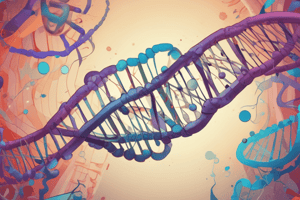Podcast
Questions and Answers
ما هو الشكل الذي يتخذة جزيئات النوكليوتيدات المكونة لجزيئات الدنا?
ما هو الشكل الذي يتخذة جزيئات النوكليوتيدات المكونة لجزيئات الدنا?
- شكل helix مزدوج (correct)
- شكل حلقي
- شكل معين
- شكل سلاسل متوازية
ما هو الجزء من جزيء الدنا الذي 编码 لتركيب البروتين في الخلايا؟
ما هو الجزء من جزيء الدنا الذي 编码 لتركيب البروتين في الخلايا؟
- قاعدة نيتروجينية
- كروموسوم
- نوكليوتيد
- جين (correct)
ما هو النوع من الارتباط الذي يحدث بين قواعد النيتروجينية في جزيء الدنا?
ما هو النوع من الارتباط الذي يحدث بين قواعد النيتروجينية في جزيء الدنا?
- ارتباط أيوني
- ارتباط كيميائي
- ارتباط هيدروجيني (correct)
- ارتباط جسدي
ما هو النوع من التplication الذي يحدث في الدنا?
ما هو النوع من التplication الذي يحدث في الدنا?
ما هو الشكل الذي تتخذة جزيئات الدنا في الخلايا الأوكاريوتية؟
ما هو الشكل الذي تتخذة جزيئات الدنا في الخلايا الأوكاريوتية؟
ما هو نوع المادة الوراثية لبعض الفيروسات?
ما هو نوع المادة الوراثية لبعض الفيروسات?
ما هو الشكل الهندسي لجزيئات الدنا؟
ما هو الشكل الهندسي لجزيئات الدنا؟
ما هو النوع من نواة قاعدة يتواجد في مناطق الغوانين الغنية في الجينوم البشري؟
ما هو النوع من نواة قاعدة يتواجد في مناطق الغوانين الغنية في الجينوم البشري؟
ما هي وظيفة إنزيم обрат.Transcriptase في فيروسات الرترو؟
ما هي وظيفة إنزيم обрат.Transcriptase في فيروسات الرترو؟
ما هو اسم العلماء الذين اكتشفوا بنية الدنا المزدوجة في عام 1953؟
ما هو اسم العلماء الذين اكتشفوا بنية الدنا المزدوجة في عام 1953؟
ما هو الغرض من زوج قواعد النيتروجيني داخل السلسلتين المزدوجتين للدنا؟
ما هو الغرض من زوج قواعد النيتروجيني داخل السلسلتين المزدوجتين للدنا؟
ما هو النتيجة الرئيسية لاكتشاف بنية الدنا المزدوجة؟
ما هو النتيجة الرئيسية لاكتشاف بنية الدنا المزدوجة؟
Flashcards are hidden until you start studying
Study Notes
DNA, the molecule at the heart of genetics, is a double helix composed of two strands of nucleotides. Each nucleotide is made up of a sugar called deoxyribose, a phosphate group, and one of four nitrogenous bases: adenine (A), cytosine (C), guanine (G), or thymine (T). These bases pair with each other through hydrogen bonds: A with T, and C with G.
The structure of DNA is highly stable, allowing it to act as a template for the replication of new DNA molecules and for the production of RNA. A segment of DNA that codes for the cell's synthesis of a specific protein is called a gene. DNA replicates by separating into two single strands, each of which serves as a template for a new strand. This process, known as semiconservative replication, ensures the stable inheritance of genetic traits.
Within a cell, DNA is organized into dense protein-DNA complexes called chromosomes. In eukaryotes, the chromosomes are located in the nucleus, although DNA is also found in mitochondria and chloroplasts. In prokaryotes, which do not have a membrane-bound nucleus, the DNA is found as a single circular chromosome in the cytoplasm. Some prokaryotes and a few eukaryotes have extrachromosomal DNA known as plasmids, which are autonomous, self-replicating genetic material. Plasmids have been used extensively in recombinant DNA technology to study gene expression.
The genetic material of viruses can be single- or double-stranded DNA or RNA. Retroviruses carry their genetic material as single-stranded RNA and produce the enzyme reverse transcriptase, which can generate DNA from the RNA strand. Four-stranded DNA complexes known as G-quadruplexes have been observed in guanine-rich areas of the human genome.
The discovery of DNA's structure was a turning point in the understanding of genetics. In 1953, James Watson and Francis Crick, aided by the work of biophysicists Rosalind Franklin and Maurice Wilkins, determined that the structure of DNA is a double-helix polymer. This breakthrough led to significant advances in scientists' understanding of DNA replication and the hereditary control of cellular activities.
DNA's structure is crucial for its function. The specific pairing of bases within the double helix ensures that the genetic information is accurately replicated and transmitted from one generation to the next. Understanding DNA's structure has also provided valuable insights into how mutations occur and how they can impact an organism's traits.
In conclusion, the structure of DNA is a double helix made up of two strands of nucleotides, each containing a deoxyribose sugar, a phosphate group, and one of four nitrogenous bases. This structure allows DNA to act as a template for replication and transcription, ensuring the stable inheritance of genetic traits. The discovery of DNA's structure was a significant milestone in the field of genetics, paving the way for further advancements in our understanding of genetic information and its role in organisms.
Studying That Suits You
Use AI to generate personalized quizzes and flashcards to suit your learning preferences.




